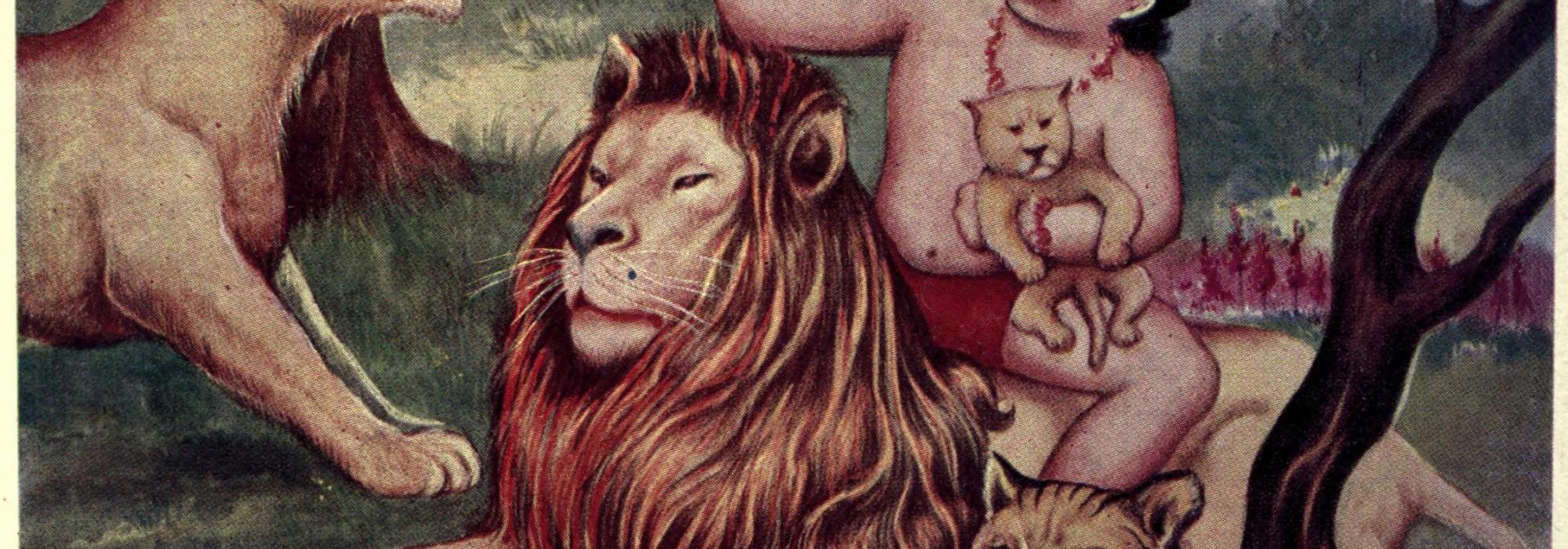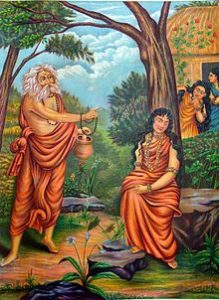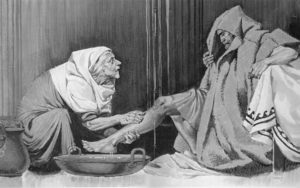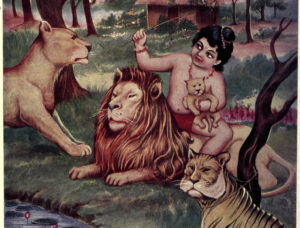Recognition and reversal (‘Anagnorisis’ and ‘Peripeteia’)
The crux of a tragedy lies in recognition and reversal. A simple plot is an action which is continuous and unitary, but whose transformation lacks reversal and recognition. A ‘complex’ plot is one whose transformation contains recognition or reversal or both. And these elements should emerge from the very structure of the plot, so that they ensue from the preceding events by necessity or probability; as it makes a great difference whether things happen because of, or only after, their antecedents (11:10-20) Reversal is a change or switching over to the opposite sequence of events.
Thus, Aristotle classifies a straight-line plot as a simple one and a curved one as a plot of a superior kind. The story of Śākuntalam is certainly not linear. Reversals happen at several instances. Some reversals are associated with recognition and a few occur due to a lack of recognition. Śakuntalā is not aware of Durvāsa’s curse and is not careful in protecting the ring that would have served as a token of identity. What would otherwise have been a smooth reunion with her husband, who had promised to have her back, changes course when he fails to identify her (in the Fifth Act). This reversal of events due to lack of recognition, that was so far linear shocks Śakuntalā and annoys Duṣyanta.
Recognition as the very name indicates, is a change from ignorance to knowledge, leading to friendship or enmity and involving matters which bear on prosperity or adversity. The finest recognition is that which occurs simultaneously with reversal. (11:21-35). Aristotle classifies recognition merely through tokens as the least artistic kind and that associated with memory as a superior kind. Recognitions for the sake of proof, and all of its types are less artistic, but those linked to reversal are superior (16:18-30). Best of all is recognition ensuing from the events themselves, where the emotional impact comes from a probable sequence, for only such recognitions do without contrived tokens and necklaces. (17:16-19)
As the very name of the play ‘Abhijñāna -Śākuntalam’ indicates, the play is about recognition, and re-cognition (‘knowing again’) after all is naturally associated with forgetfulness. This forgetfulness is not intentional, but is found at different levels, starting from Śakuntalā’s lapse in forgetting her duty towards the guest Durvāsa, immersed as she is in her own thoughts about Duṣyanta. Thus, the seed of the whole play lies in love, which leads to forgetfulness, reversal, suffering, recognition and further reversals. Here, recognition is not limited to the proof of a person’s identity, but it also revives memory, and further repetition of events makes the reversals even stronger in impact.
Unlike in the bath scene of the Odyssey, where Odysseus’ scar functions as a mere indicator of his identity, and the bending of his old bow serves as proof thereof, in Śākuntalam, the ring serves the higher purpose of bringing back memories to Duṣyanta, and hence bringing about a complete reversal of the story. Had the ring been with Śakuntalā when she arrived at Duṣyanta’s court in the Fifth Act, it would have merely served as a sign of her identity, making it an inferior form of recognition, according to Aristotle. The Vidūṣaka (i.e., the jester) is conspicuously absent in the Fifth Act, when Śakuntalā arrives at the king’s court. Even if he had been present, he probably would not have reminded Duṣyanta, since he had already told him (in the Second Act) that he was merely joking about his love for the girl Śakuntalā. When she now discovers that she has lost the memento that was given to her by Duṣyanta, she describes certain intimate moments she had spent in his company, connected with the deer named Dīrghāpāṅga. Even this narration of events fails to trigger anything in Duṣyanta’s memory, or to act as a sign of recognition. The initial loss of the ring and its subsequent retrieval brings back recognition, not only as proof of identity, but also enkindles Duṣyanta’s memory, and engenders in him the hope of finding a successor to his dynasty. Thus, in Aristotle's eyes, this technique of recognition adds to the drama, and Kālidāsa would clearly merit his appreciation for employing recognition and reversal of a superior kind.
Further recollection and reversal happen in the Sixth Act of the play, when Duṣyanta sees Śakuntalā in flesh and blood in a painting that he has made of her. Firstly, the fact that he is able to paint her likeness proves that the ring has served its purpose, and that his memory of her is now intact. It is only because she has now occupied his mind totally that he is able to express his recollection through a painting. His recollection is also aided by the repetition of events that took place in the First Act, but which are now spun around the image of Śakuntalā. It is not just Duṣyanta who takes the painting for the real Śakuntalā; even a bee is tricked by its life-like quality and attacks her lips. Just as her friends in the First Act had playfully said that only the King Duṣyanta could possibly rescue her from the torment of the bee (“दुष्यन्तमाक्रन्द | राजरक्षितव्यानि तपोवनानि नाम |”) and he had then jumped to her rescue, in the Sixth Act, too, the Vidūṣaka taunts him saying that it is his duty to protect her (“भवानेवाविनीतानां शासिताSस्य वारणे प्रभविष्यति”). Duṣyanta now remarks:
दर्शनसुखमनुभवतः साक्षादिव तन्मयेन हृदयेन |
स्मृतिकारिणा त्वया मे पुनरपि चित्रीकृता कान्ता ||
(I am experiencing the delight of beholding my beloved as if she were present before me, with my heart engrossed in her. You have, by reviving my memory, metamorphosed her again into a painting)
This certainly qualifies as the best of all kinds of recognition in the Aristotelian system, and here Kālidāsa’s technique of mirror-imaging events is remarkable. The recognition is not merely limited to the proof of a person’s identity, it also serves to revive memory and the further repetition of events make the reversals stronger. This constitutes, in Aristotle’s words, ‘compound recognition’ (17:10-15). R Ganesh in his essay [9] shows in detail the technique of lateral-inversion of the events of the first three acts and the last three acts, with the Fourth Act as the fulcrum.
There are also other events throughout the play that bring partial recollections to Duṣyanta’s sub-conscious mind, but he is not able to make sense of them. When he hears Hamsapadikā singing, he says ‘किं नु खलु गीतमेवंविधार्थमाकर्ण्येष्टजनविरहादृतेऽपि बलवदुत्कण्ठितोऽस्मि |’ – although this could be a mere reaction to her melodic singing, it stands as an alibi to Duṣyanta’s lapse of memory and his subconscious craving. He goes on to say – “तच्चेतसा स्मरति नूनमबोधपूर्वं भावस्थिराणि जननान्तरसौहृदानि” (5.2, “He recalls, although not consciously aware, friendships of past lives that have remained permanently impressed”). After Śakuntalā and her aides leave the king’s court, the king again feels a subconscious twinge. In the last verse (verse 31) of the Fifth Act, he reflects that although his memory does not recall, his heart makes him believe that he had married her before.
In the Seventh Act, Duṣyanta visits Mārichā’s āśrama to find a child playing with a lion cub. This is none other than Śākuntala-Bharata, his own son by Śakuntalā. Though unaware of the child’s identity, Duṣyanta feels fatherly affection for him even at first sight (“अस्मिन्नौरस इव पुत्रे स्निह्यति मे मनः”). The recognition of the child progresses through several stages: he first sees that the child bears the mark of an emperor in his hands (“चक्रवर्तिलक्षणमप्यनेन धार्यते”). When he touches the child, a female ascetic observes that the child is not shying away from him although he was not acquainted with him, and also adds that he belongs to the race of Puru. Duṣyanta’s hope is further kindled when he hears that the child was borne by a lady who is associated with an apsara. He is still not entirely convinced even when the child gets confused with the phrase (śakuntalāvaṇyam) as a reference to his mother, thinking that it is quite possible for many people to bear the same name ‘Śakuntalā’. The king’s connection with the child is ascertained when he picks up the child’s special bracelet, which had been designed by the sage Mārīca in such a way that it would turn into a snake if touched by a person other than the child’s parents, and it still remains unchanged. When he comes to know of this, all of Duṣyanta’s doubts are cleared and he is now sure of the child’s identity. (He says, “कथमिव सम्पूर्णमपि मे मनोरथं नाभिनन्दामि” – How indeed will I celebrate the fulfilment of my desire). He thus overcomes his anxiety and guilt over having abandoned Śakuntalā, and not being able to find her again. He recognizes the presence of Śakuntalā through Śākuntala, thus justifying the name of the play ‘Abhijñāna-Śākuntalam’. He is overcome with joy and says that his loss of memory, which was like an eclipse, has now passed, and that it is as though the moon has been reunited with Rohiṇī (7.22), and begs her pardon for having abandoned her earlier, like a blind man who shakes off a precious garland of flowers that is thrown over his head, mistaking it for a serpent. (7.24).
Towards the end of the play, the poet summarizes the events through Duṣyanta’s words –
यथा गजो नेति समक्षरूपे तस्मिन्नपक्रामति संशयः स्यात् |
पदानि दृष्ट्वा तु भवेत्प्रतीतिस्तथाविधो मे मनसो विकारः || (7.31)
At times, we are convinced that an elephant which is right in front of our eyes is not an elephant. And the moment it moves away, we begin to wonder if it was indeed an elephant, and then, on seeing its footprints, we are convinced that it really was one. Even so was the delusion that had distorted my mind.
Thus, the philosophy of the play lies in sammoha and pratibodha – delusion (illusion of reality) and dawning (of the truth).



















































